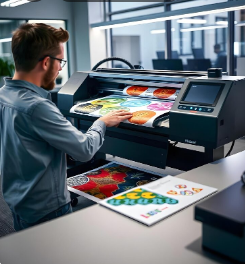In the competitive landscape of modern entrepreneurship, small businesses are increasingly turning to innovative technologies to differentiate themselves and enhance profitability. One of the most transformative solutions in this space is DTF printers for small business. Unlike traditional printing techniques, Direct-to-Film (DTF) technology offers flexibility, affordability, and high-quality output that aligns perfectly with the evolving needs of small enterprises. By adopting DTF printing, businesses can unlock new revenue streams, reduce operational costs, and scale efficiently, making it a powerful tool for business model innovation.
Understanding the Essence of Business Model Innovation:
Business model innovation refers to rethinking the way a company creates, delivers, and captures value. For small enterprises, this often involves introducing cost-effective methods, diversifying product lines, and leveraging new technologies to remain competitive. In this regard, DTF printing stands out as a catalyst for transformation. Unlike outdated methods such as screen printing or vinyl transfers, DTF provides more versatility at a lower cost, enabling small businesses to redefine their value propositions without large investments.
Why DTF Printing Appeals to Small Enterprises:
Small businesses face unique challenges: limited budgets, low workforce capacity, and the need to stand out in saturated markets. DTF printing addresses these pain points directly:
- Low entry costs: Initial investments are significantly lower than other printing technologies.
- Versatility : DTF works seamlessly on cotton, polyester, blends, leather, and more, allowing businesses to expand into multiple markets.
- High-quality output : Prints are durable, vibrant, and resistant to washing, which improves customer satisfaction and repeat purchases.
- On-demand production : Small enterprises can avoid large inventory costs by producing only what customers order.
Together, these features enable small businesses to innovate their business models by offering customized products, reducing waste, and delivering faster turnarounds.
New Revenue Streams Through Customization:
One of the most effective ways small businesses innovate is by creating additional income streams. With DTF technology, companies can move beyond basic apparel and diversify into areas like tote bags, caps, footwear, promotional items, and even home décor. Personalized merchandise, particularly in the age of e-commerce and social media-driven consumer behavior, has become a highly profitable market.
For example, a small clothing boutique can leverage DTF printing to offer exclusive seasonal collections or limited-edition designs without overproducing. Similarly, event planners or marketing agencies can provide custom-printed giveaways for clients, opening doors to B2B partnerships. This flexibility in offerings is a hallmark of sustainable business model innovation.
Scalability and Operational Efficiency:
Scalability is another core aspect of business model innovation. With traditional methods, scaling often means heavy investments in equipment and labor. In contrast, DTF printing requires minimal resources to handle increased demand. Small enterprises can start with a compact setup and expand gradually as orders grow, avoiding financial strain.
Moreover, DTF reduces dependency on skilled technicians, making operations simpler and more accessible for small teams. The efficiency gained from quick setup times and consistent results allows entrepreneurs to focus more on marketing, customer engagement, and brand growth rather than production bottlenecks.
Cost Reduction and Sustainability:
An innovative business model doesn’t just rely on generating revenue—it also focuses on minimizing costs and improving sustainability. DTF technology supports these goals by:
- Reducing waste : Only the required amount of film and powder is used.
- Lowering labor costs : The automation of processes decreases the need for large teams.
- Eco-friendly practices : Many DTF inks are water-based, reducing environmental impact.
For small enterprises, this not only improves profitability but also aligns with growing consumer demand for sustainable practices, thereby enhancing brand reputation.
Midway Transformation: The Role of DTF LINKO:
When discussing innovation, it’s impossible to ignore the impact of industry leaders that are advancing the DTF ecosystem. One such key player is DTF LINKO. Known for its reliable machines and high-quality printing solutions, LINKO is helping small businesses bridge the gap between creativity and execution. Their range of DTF printers allows entrepreneurs to experiment with new business models while maintaining cost-effectiveness and print quality.
By adopting such advanced tools, small enterprises not only streamline their workflows but also position themselves competitively against larger players in the market. This makes DTF printing not just a technology upgrade but a strategic investment in long-term innovation.
Case Study: Transforming a Small Apparel Startup:
Consider a small startup specializing in streetwear fashion. Initially, they relied on outsourced screen printing, which limited their design flexibility and profit margins. After switching to DTF printing, they gained full creative control, enabling rapid product launches tailored to market trends.
The business expanded its catalog to include hats, jackets, and eco-friendly tote bags—all produced in-house. By adopting a print-on-demand model, they reduced inventory costs by 40% and boosted customer satisfaction through personalized designs. Within a year, their revenue doubled, proving how DTF printing directly contributes to business model innovation.
Future Outlook: DTF Printing as a Growth Engine:
As consumer preferences continue to evolve, small enterprises must remain agile. DTF technology is expected to play a central role in shaping the future of printing for small businesses. Innovations such as automated workflows, AI-driven design integration, and sustainable ink formulations will further empower entrepreneurs to refine their models.
Those who embrace DTF early not only gain a competitive advantage but also future-proof their operations against shifting market dynamics.
Conclusion:
Business model innovation is no longer optional for small enterprises—it is essential for survival and growth. DTF printing has emerged as a groundbreaking tool that enables entrepreneurs to rethink their strategies, diversify offerings, scale sustainably, and deliver exceptional value to customers. From cost savings to new revenue opportunities, the technology provides an all-in-one solution for innovation.
For small businesses aiming to stay relevant and profitable, adopting DTF is more than just a printing upgrade—it’s a strategic evolution. By leveraging advanced solutions from providers like LINKO, entrepreneurs can transform challenges into opportunities and secure long-term success in an increasingly competitive market.



